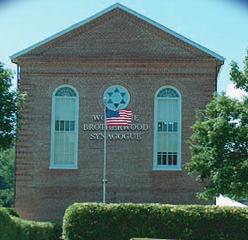 |
|
| Contents | |
| Farming Communities of NJ Homepage |
|
| Alliance,
Norma & Brotmanville |
|
| Woodbine | |
| Rosenhayn and Carmel | |
| Roosevelt |
|
| Farmingdale | |
| After World War II | |
| Synagogues
of Other Farming Communities |
|
| In the News | |
| Resources | |
| Memories | |
| Photos | |
| JewishGen
Home Page |
|
| KehilaLinks Home Page |
|
|
| Woodbine
was the largest of the Jewish farming communities
established in South Jersey. Located about 30
miles southwest of Atlantic City, it was founded in
1891 with 300 Russian and Rumanian Jews who settled
on land purchased by the Baron de Hirsch Fund.
With the aim of establishing a model agricultural community, the settlers quickly realized how difficult it was to earn a living on this land. Within the first year the factories were introduced for soft goods, particularly clothing. In 1903, Woodbine was incorporated as an all-Jewish town. All public offices, police and fire departments were filled by Jews. Among the public institutions established were a town board of health, Village Improvement Association and an Education Alliance. The most important buildings in the colony were the synagogue and the Talmud Torah. A benevolent society, Woodbine Brotherhood (Agudath Achim Anshei Woodbine) was created to give charity, support the sick and provide funerals to its members. The society built the Woodbine Brotherhood Synagogue which was dedicated in 1896 and is now listed as a National Historic Landmark.
The first agricultural high school was founded in Woodbine ca. 1900, the Baron de Hirsch Agricultural School. Many agricultural developments were pioneered by the teachers, researchers, agronomists and soil chemists associated with the Agricultural School. In 1905, there were 350 families, numbering 2100 people. Manufacturing was introduced to help supplement colonists income from farming. It also provided funding organizations with the hope of moving immigrants out of the sweatshops of the cities into a pleasant rural setting. The settlers worked in three clothing factories and a rubber factory. During World War II, the factories manufactured for government needs. There were still about thirty poultry farms and about twenty orchard farms around Woodbine. The colony took pride in the children receiving a fine American education in Woodbine. By 1920, a majority of children went on to high school. Few remained on the farms of their parents or the local factories. They sought their fortunes in the cities. There are very few Jews left in Woodbine. |
